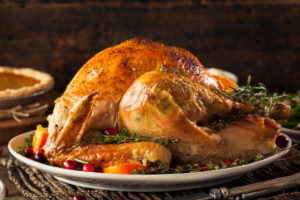When you think of Thanksgiving, what comes to mind? Turkey! The U.S. Department of Agriculture says more than 46 million turkeys are cooked and eaten in the U.S. over the Thanksgiving holiday. That number represents one-sixth of all the turkeys sold in the U.S. each year.
Dodge County Extension has a few tips that will ensure that your Thanksgiving meal is safe and delicious.
“Thawing and cooking are the two challenges any holiday cook will face,” according to Barbara Ingham,
extension food safety specialist with the Division of Extension.
When thawing the turkey in the refrigerator, the USDA recommends allowing 24 hours for every four to five pounds of meat. For example, a 16 to 20-pound turkey would need at least three or four days to thaw. Some newer, more efficient refrigerators can add a day or two to that time. Turkeys can also be thawed in the microwave, or in a sink filled with cold water—just change the water every 30 minutes. It’s also possible to cook a turkey directly from the frozen state, adds Ingham.
In addition to the challenge of thawing a turkey, consumers struggle with other questions such as knowing when a turkey is sufficiently cooked, and how to handle leftovers, says Pattie Carroll, Dodge County Division of Extension.
Carroll recommends cooking your Thanksgiving turkey to an internal temperature of 165°F, as measured with a food thermometer. Check the temperature several places, the thickest part of the breast, the inner thigh, and the wing. Check the temperature of stuffing too. All turkey meat, including any that remains pink, is safe as soon as all parts reach 165°F, she says.
Once thoroughly cooked, proper cooling and handling of leftover is a key food safety step.
“Refrigerate leftovers within two hours,” advises Ingham. Cut turkey into smaller pieces and place in shallow containers for quick cooling in the refrigerator. Place leftover sauces, dressing, and any side dishes in the refrigerator within two hours as well. Use leftovers within four days or freeze for longer storage.
Dessert is a part of many Thanksgiving meals. Carroll notes that pumpkin pie, custard pie and cheesecake must also be handled safely. Bake these festive desserts to a safe minimum internal temperature of 160°F. Once cool, refrigerate until the big meal. Carroll also follow-ups that pumpkin or cream pie that you purchase from the market or grocery are also safest stored in the refrigerator once you bring them home.
The Dodge County Division of Extension office is available to help answer your holiday meal preparation
questions. For last minute questions, refer to these holiday hotlines:



